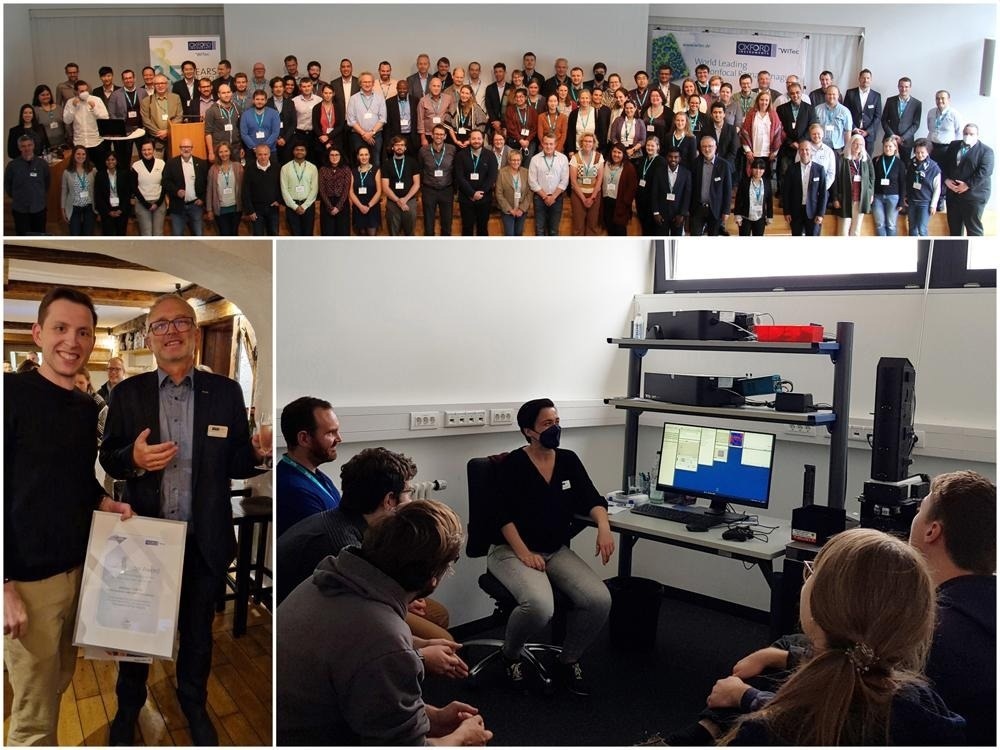From WITec GmbHReviewed by Maria OsipovaOct 6 2022
For 2022, the Confocal Raman Imaging Symposium once again brought the molecular imaging community together in person. WITec welcomed researchers from around the world for three days of presentations, discussions, poster sessions and equipment demonstrations. 120 participants and 29 posters filled Ulm’s Stadthaus and the direct, spontaneous interaction at the core of scientific collaboration was on full display.
 Symposium Collage - (Upper Image) Group Photo; (Lower Right) WITec Equipment Demo Group; (Lower Left) Poster Award Winner Johannes T. Kehren with WITec Co-founder and Managing Director Joachim Koenen. Image Credit: WITec GmbH
Symposium Collage - (Upper Image) Group Photo; (Lower Right) WITec Equipment Demo Group; (Lower Left) Poster Award Winner Johannes T. Kehren with WITec Co-founder and Managing Director Joachim Koenen. Image Credit: WITec GmbH
WITec Marketing Director Harald Fischer set the conference in motion with a greeting and Dr. Thomas Dieing gave an overview of Raman microscopy technologies and correlative variations thereof. Prof. Sebastian Schluecker provided a detailed introduction to the technique itself and Prof. Juergen Popp shared insight into cutting-edge Raman imaging for medical applications and biomedical research. The evening lecture focused on Ulm’s most esteemed citizen, Albert Einstein, and was delivered by Dr. Nancy Hecker-Denschlag of the Albert Einstein Discovery Center Ulm.
The second day featured a diverse lineup of speakers presenting their work in the categories of: Geo and Environmental Sciences, Life Sciences and Pharmaceutics, and Advanced Imaging and Materials Analysis. During breaks and dedicated sessions, attendees browsed the entrants in the poster competition and chatted with their authors. From the ultra-modern Stadthaus, the event relocated to a 700-year-old restaurant in Ulm for dinner.
It was there that the 2022 Poster Award was presented to Johannes T. Kehren from Hochschule Koblenz in Höhr-Grenzhausen for his work: Nitride Bonded Silicon Carbide (NBSC) The Formation of Si₃N₄ Studied by in situ Hyperspectral Raman Imaging. Together with his colleague Olaf Krause, he investigated NBSC using Raman spectroscopy to better understand this material group, which is ideal for use in the recuperator system of waste incineration plants.
On the third day the conference moved to WITec’s recently expanded headquarters for a showcase of the latest developments in Raman microscope and software technology, carried out in new demo laboratories.
There was something for just about everyone this year: microplastics, life sciences and biomedicine, astromaterials, plant cell biology, low-dimensional materials, soil science, and pharmaceutical research. These topics were accompanied by talks on advanced techniques such as correlative Raman-SEM-EDS analysis, Raman calibration standards, and cryogenic Raman imaging.
The Symposium in Ulm was a resounding success, with a record number of participants, a varied program, and a very competitive group of posters that reflected the ever-broadening application of Raman microscopy.
Perhaps most importantly, it cultivated a sense of community and provided a forum for the discussion of the field’s most recent discoveries.
We look forward to continuing this tradition next year at the 19th Confocal Raman Imaging Symposium: September 25-27, 2023 www.raman-symposium.com